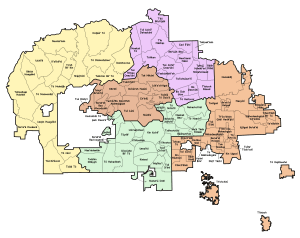Ramah Navajo Indian Reservation facts for kids

The Ramah Navajo Indian Reservation (called Navajo: Tł'ohchiní in Navajo) is a special part of the Navajo Nation. It is located in New Mexico, near the Zuni Indian Reservation. This area is not directly connected to the main Navajo Nation lands.
The reservation covers about 230 square miles (597 square kilometers). Most of this land is "trust land," which means it is held by the U.S. government for the benefit of the tribe. In 2000, about 2,167 people lived here. The Ramah Reservation is a small but important part of the Navajo Nation.
Even though it's part of the Navajo Nation, the Ramah Navajo have a unique history. They have lived in this part of New Mexico since at least 1540. At that time, they even helped the Zuni defend themselves against a Spanish explorer named Francisco Vásquez de Coronado.
For many years, from 1868 to the 1960s, the Ramah Navajo managed their affairs mostly on their own. Since the 1960s, they have been officially part of the Navajo Nation. They were pioneers in many ways. They created the Pine Hill community, which includes the Pine Hill Navajo School and a health clinic. In the early 1970s, leaders and a lawyer named Michael Gross worked to get money directly from the U.S. Congress for these important services.
For a long time, the Ramah Navajo did not have full legal rights to their lands under U.S. law. This meant they could not get all the services and benefits that other federally recognized tribes received. In 1979, a volunteer named Jan Crull, Jr. helped them. He worked to pass Public Law 96-333, which secured their land rights. He also taught them how to get rights to the minerals under their land through Public Law 97-434. His work was so important that he was nominated for a special award in 1981.
Contents
The Ramah Navajo Reservation is special because it has its own police force. It also has its own police district. In 2016, a new detention center was opened. This helps the community stay safe and manage its own law enforcement.
The Ramah Navajo Chapter has a representative named Norman M. Begay. He is one of 24 Council Delegates. These delegates represent the 110 Chapters of the Navajo Nation. Mr. Begay also represents two other areas, Alamo and To'Hajiilee. He is part of the Navajo Nation Budget and Finance Committee. This committee helps decide how the Nation's money is spent.
Education: Learning and Growing
There is a tribal school system called Pine Hill Schools. The Ramah Navajo School Board runs these schools. They work with the Bureau of Indian Education (BIE).
Local public schools are managed by the Gallup-McKinley County Schools district. Because the nearest schools in Cibola County were too far away (about 50 miles or 80 kilometers), Cibola and McKinley counties agreed to send students to McKinley County schools. Since 1995, buses take students from the reservation to schools in Ramah Village. These include Ramah Elementary School and Ramah Middle/High School.
In the past, Native American students from the reservation often went to boarding schools. These schools were run by the Bureau of Indian Affairs (BIA) in New Mexico and other states. In 1943, the BIA opened Mountain View Day School on the reservation for younger students.
In 1952, the Ramah Navajo people voted on a plan. They decided to send their children to a BIA dormitory in Ramah Village. This dormitory was near public schools. The U.S. government agreed to pay New Mexico for Native American children attending public schools. The dormitory opened in 1954, and Mountain View Day School closed. This meant most students could attend a local public school.
Around 1968, the public high school in Ramah Village closed because it was unsafe. High school students then had to go to distant BIA boarding schools. The dormitory in Ramah only took elementary students. The Gallup-McKinley school district did not provide busing to other public schools.
In 1968, the Navajo Legal System Program (DNA) sued the school district. They wanted the public school to reopen. The courts decided that the reservation could have busing to Zuni Public Schools. However, the Gallup-McKinley County district chose not to send its buses into Cibola County, where the reservation is.
Because of this, the Ramah Navajo Indian School Board was created in 1970. They planned to open their own tribal school. This school opened in 1970 in the old Ramah School building. In 1975, the tribal school moved to Pine Hill. The Ramah Village public high school reopened in 1983.
In 1994, the Ramah tribal government and the governments of Cibola County and McKinley County made an agreement. They decided to have two bus stops on the Ramah reservation. These stops were at the chapter house and another point to the south. The New Mexico State Superintendent of Education, Alan Morgan, approved this.
However, parents did not like the new bus stops. They said the stops were unsafe and did not have enough space. Mr. Morgan then approved new stops deeper inside the reservation. These new stops were near Pine Hill schools and a housing complex. They started in December 1994.
In January 1995, the Ramah Navajo chapter and the Ramah Navajo School Board sued the New Mexico Public Education Department and Gallup McKinley County Schools. They argued that allowing school buses deeper into the reservation was wrong. They said it took students away from Pine Hill Schools. They also said it broke the earlier agreement between the tribe and the counties.

